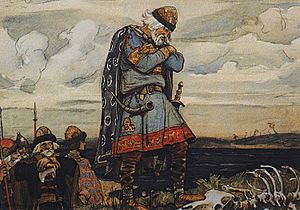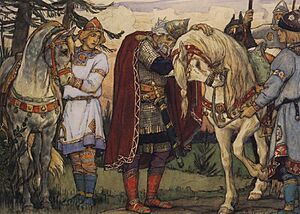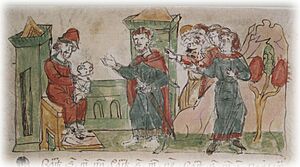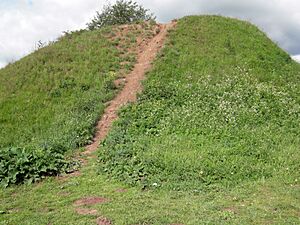Oleg the Wise facts for kids
Quick facts for kids Oleg |
|
|---|---|

Lay of Oleg the Wise by Viktor Vasnetsov (1899)
|
|
| Prince of Kiev | |
| Reign | 881/2/889 – 912/922/940s |
| Predecessor | Askold and Dir |
| Successor | Igor |
| Prince of Novgorod | |
| Reign | 879–912 |
| Predecessor | Rurik? |
| Successor | Igor |
| Died | 912 |
| Burial | Kiev (PVL) or Ladoga (NPL) |
| Dynasty | disputed |
| Father | unknown |
| Religion | Old Norse religion |
Oleg (also known as Oleg the Wise) was a brave Viking prince from the group of people called the Rus'. He became the ruler of Kiev and helped create the important state known as Kievan Rus'.
According to old stories, Oleg took over from his relative Rurik as the leader of Novgorod. He then brought many East Slavic tribes under his control, expanding his power south along the Dnieper river. Oleg also led a successful attack on Constantinople, a very important city at that time. He passed away in 912, and Igor, Rurik's son, became the next ruler.
Some historians have different ideas about when Oleg lived and ruled. They point to other old writings that suggest he might have been active even later, in the 940s. The exact connection between Oleg and Rurik's family, especially with Igor, is still a topic of discussion among experts.
Contents
Oleg's Adventures in Old Stories
Old books called chronicles tell us about Oleg. A chronicle is like a historical diary kept by people long ago. The Primary Chronicle says Oleg was a "relative" of Rurik. Rurik trusted Oleg to look after his kingdom and his young son, Igor. However, some modern historians are not sure if Oleg was truly related to Rurik.
Oleg is said to have become the ruler of Novgorod in 879. Then, around 881–882, he took control of Smolensk. After that, he used a clever trick to defeat and kill Askold and Dir in Kiev. He then made himself the prince of Kiev. This event is often seen as the beginning of the Kievan Rus' state.
In 883, Oleg made the Drevlians tribe pay tribute to Kiev. Tribute was like a payment or tax. Later, in 907, the Drevlians joined Oleg's army in a big fight against the Byzantine Empire. This was the Rus'-Byzantine War (907) against their capital city, Constantinople.

Historians have different views on this war. Some believe the Rus' faced a tough fight and the peace treaty they got was more like a "gift" from the Byzantines. Others think the treaty was very good for the Rus' people.

Another old book, the Novgorod First Chronicle, tells a slightly different story. It says Oleg was not related to Rurik. Instead, he was a Viking leader who worked as Igor's army commander. This chronicle also says Oleg died in 922, not 912. The Primary Chronicle says Oleg's grave is in Kiev. But the Novgorod stories say he was buried in a burial mound (a large pile of earth over a grave) in Ladoga.
The Legend of Oleg's Death
In the Primary Chronicle, Oleg is sometimes called "the Prophet." This name comes from his Norse name, which means "priest." There's a famous legend about his death, which was even turned into a poem by Alexander Pushkin.
The story says that pagan priests told Oleg he would die because of his favorite horse. To try and avoid this, Oleg sent his horse away. Many years later, he asked what happened to his horse and was told it had died. Oleg wanted to see its remains. When he touched the horse's skull with his boot, a snake slithered out and bit him. Oleg died from the bite, and the prophecy came true.
This legend is similar to other old stories from different cultures where a hero's death is connected to a prophecy, an animal, and a specific object. A similar tale can be found in an old Scandinavian story from the 13th century.
Oleg in Other Historical Records
The Primary Chronicle says Oleg died in 912, and Igor ruled after him until 945. However, another old document, called the Schechter Letter, tells a different story. This letter was written by a Jewish person from a group called the Khazars. It talks about a Rus' warlord named HLGW (which sounds like "Helgu" or "Oleg") who was active as late as the 940s.
For a long time, many historians didn't pay much attention to the Schechter Letter. But recently, some experts like David Christian and Constantine Zuckerman have suggested that this letter might be true. They think it shows there was a power struggle in the early Rus' state between those loyal to Oleg and those loyal to Igor. Oleg might have lost this struggle.
These historians also believe that the Khazars might have controlled Kiev until the early 900s, not 882 as traditionally thought. They also suggest that Igor might not have been Rurik's direct son, and there might have been a missing generation of rulers between Rurik and his known successors.
What's really interesting is that the Schechter Letter's description of Oleg's death (that he fled and raided a place possibly in Persia and was killed there) is very similar to what Arab historians wrote. They described a Rus' attack on a Muslim state in 944/5, which matches the timeline in the Schechter Letter.
Trying to Understand All the Stories
It's tricky to make all these different stories fit together. The Primary Chronicle and another book, the Kiev Chronicle, say Oleg's grave is in Kiev. People could even see it when these books were written. But if Oleg became ruler in 879, as the East Slavic chronicles say, it's hard to imagine him still being active almost 70 years later in the 940s. That would mean he lived an incredibly long life for that time!
To try and solve this puzzle, some historians have suggested different ideas. One idea is that "Helgu" (Oleg) might have been a title used by pagan rulers, meaning "holy" in the Norse language. So, Igor and others might have also used this title.
Another idea is that the Helgu-Oleg mentioned in the 940s was a different person entirely. He could have been one of the "fair and great princes" mentioned in treaties between the Rus' and Byzantines, or one of the "archons of Rus" (leaders of Rus') mentioned in another old book.
Some historians have even thought that the Oleg from the Schechter Letter could be Igor's oldest son, whose wife is mentioned in a treaty from 944. Or, he might have been a local prince from Chernigov, a city that had close ties with the Khazars. This is supported by findings at a large royal burial mound near Chernigov.
See also
 In Spanish: Oleg de Nóvgorod para niños
In Spanish: Oleg de Nóvgorod para niños




